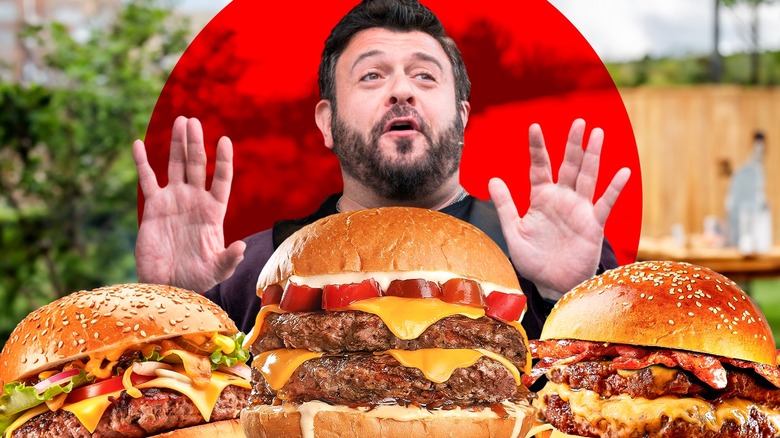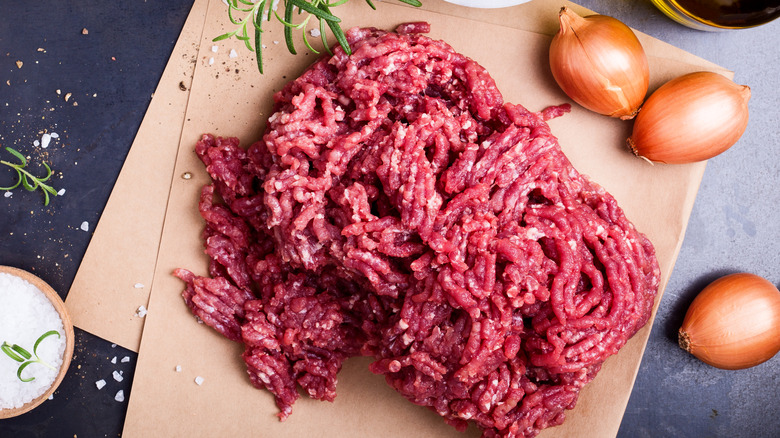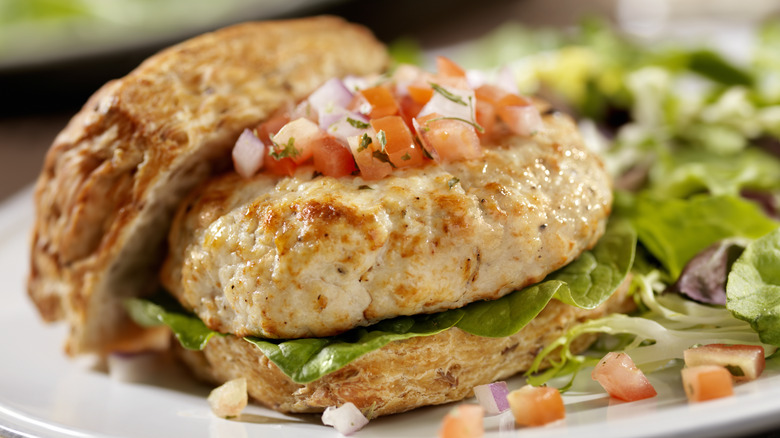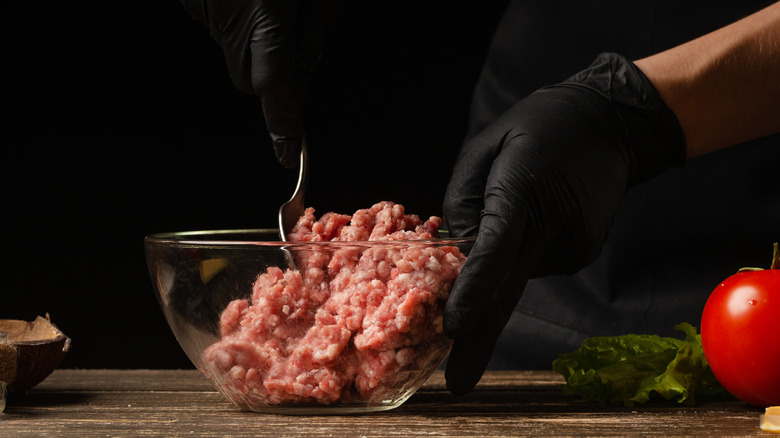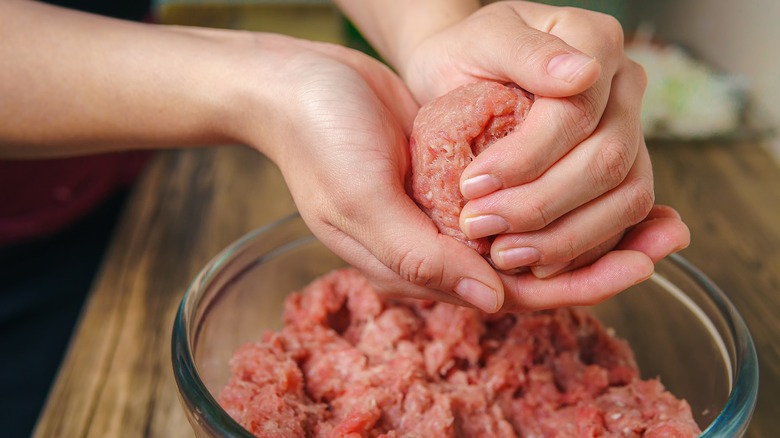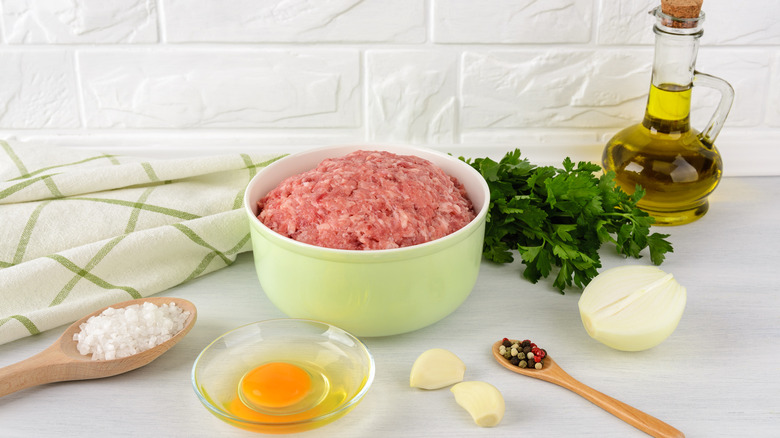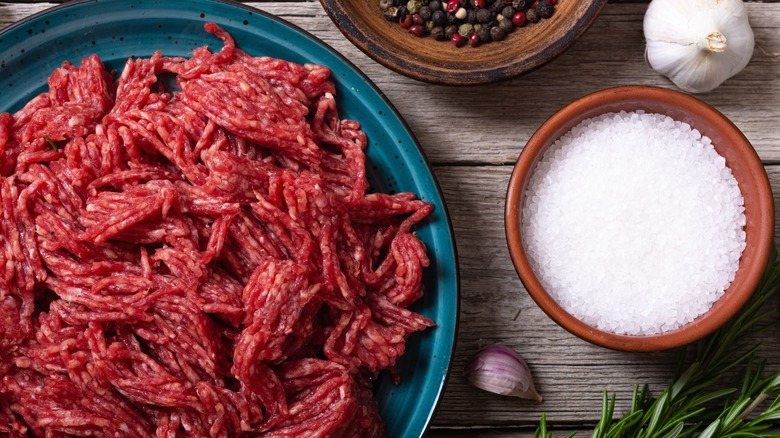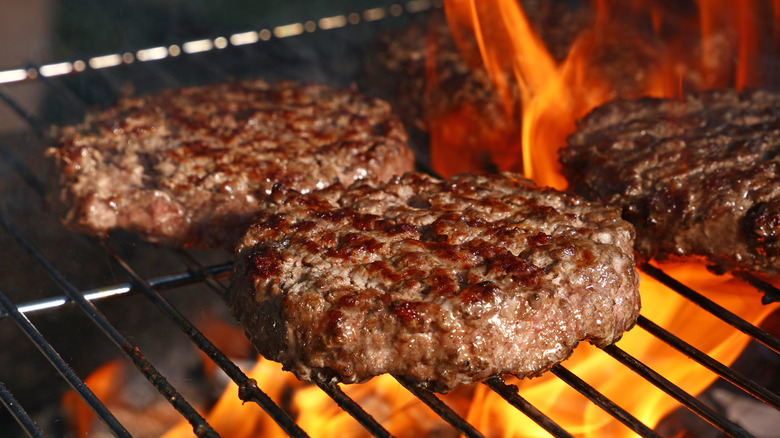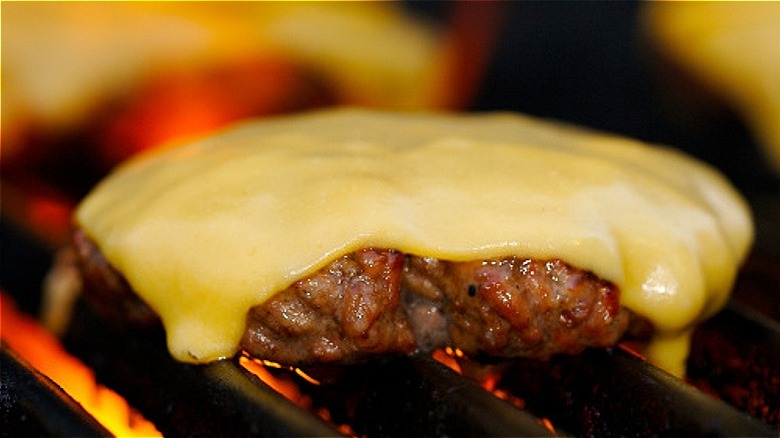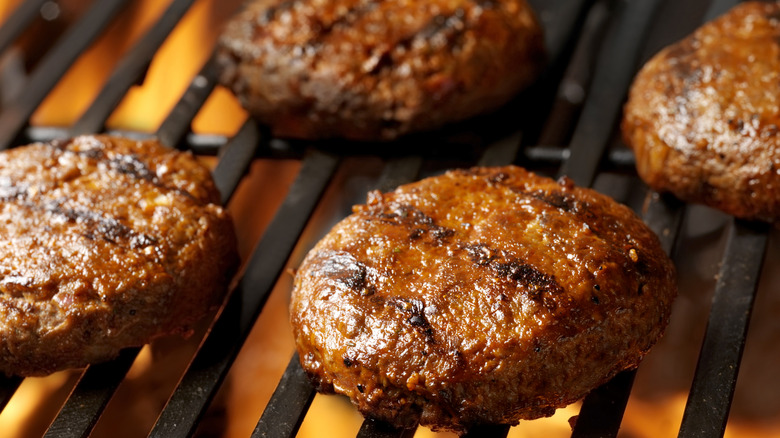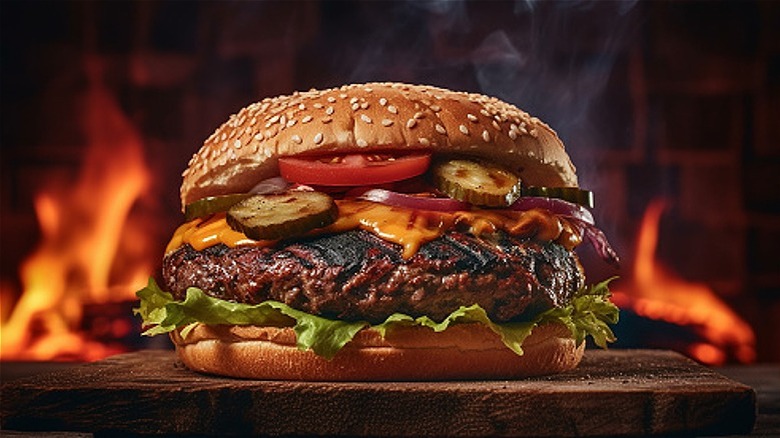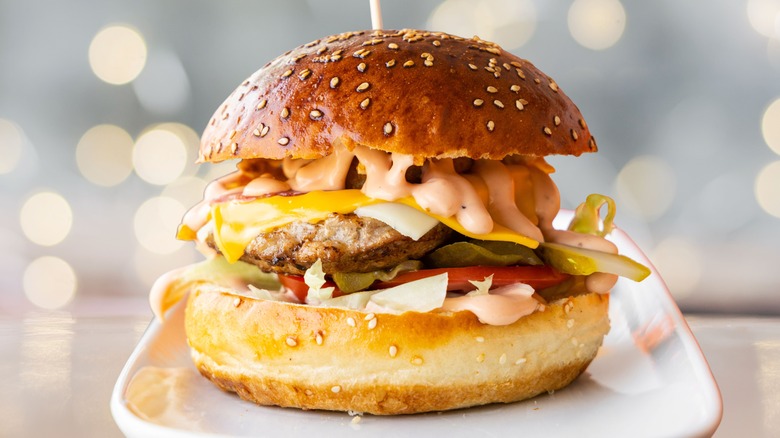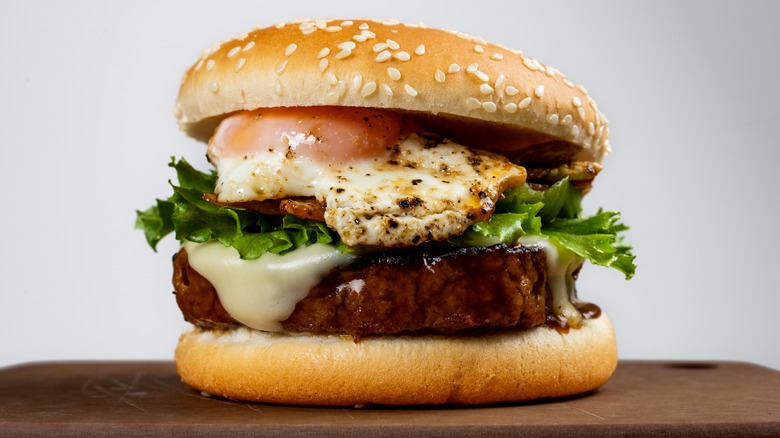12 Mistakes Everyone Makes When Grilling Burgers, According To Adam Richman
Grilling a burger sounds easy — take a chunk of ground meat, roll it like a meatball, press it into a patty, and slap it on the grill to cook. But from the moment you purchase the ground meat to the point when you take your first bite, there are various steps that could go sideways on your path to creating a masterful burger. It takes more than just haphazardly shaping meat and throwing it on your grill. But don't let that deter you from making delicious burgers at home. While many restaurants exist to deliver the best burgers in the U.S., nothing compares to firing up the grill, listening to birds chirp and kids play, and smelling the intoxicating aroma of a wood fire while lounging poolside.
Some folks debate whether the top way to cook burgers is by searing them on a flat surface, like a cast iron griddle, versus directly on the grill grate. Whichever way you choose to grill burgers, knowing which mistakes to avoid when grilling them can help you craft one of the best burgers you've ever had. To give us the low-down on grilling burgers, we spoke with the man who has tried everything, Adam Richman. He's an author, producer, cook, and television host. From the right amount of fat in the meat to melting the cheese on your burger like a pro, these tips stemming from Richman's love for a good burger will put you on track to avoid the most common mistakes.
1. Using meat that features too much fat
Achieving a great burger begins with the best cut of meat for mincing, which is typically beef chuck. Of course, you can make burgers with just about any type of meat, like lamb or pork shoulder. But the fat to protein ratio is an important factor to keep in mind, says TV and food personality Adam Richman. You want your burger to have just enough fat but not be overwhelmingly greasy.
Whether you're making traditional burgers or smashburgers, an 80/20 protein to fat ratio makes for the ideal burger to bite into, according to Richman. "I can maybe go up to 25% fat, but I find the same issues I have with A5 Wagyu — too fatty, too rich," he says. Though you want a decent amount of fat to make juicy, melt-in-your-mouth burgers, too much of the good stuff can actually ruin your burger. Besides, as Richman points out, "If I'm adding cheese, special sauce, etc., there's already additional fat, so it's not necessary."
2. Using meat that's too lean
Any cut of meat can be minced. Therefore, any cut of meat can become your next burger. If you opt for a lean cut of meat, such as chicken, turkey, elk, or venison, you'll need to compensate for the lack of fat, advises Adam Richman. You can do this in a number of ways. Richman suggests "making a thinner patty, adjusting your cooking temp so as not to lose too much fat, cooking the burgers in a fatty substrate like grass-fed butter, or even blending in the cheese of your choice right into the patty."
Grilling lean meat is at risk of drying out due to having less moisture during the cooking process. Adding fat to your meat is a simple solution to overcome this issue. You can use a variety of fats, such as tallow, lard, or dairy, but pairing a fat that complements your cut of meat can make a difference in the resulting taste. For instance, adding butter to elk burgers brings out the protein's rich, wild game taste. Using a panade (a mixture of bread and milk that serves as a paste) can help you create perfectly juicy chicken burgers. And feta cheese keeps turkey moist while adding a Greek flavor to burger sliders.
3. Overworking your meat while making burgers
One of the most common mistakes everyone makes with hamburgers is handling the meat too much. Shaping a burger seems like it should be an easy task. Yet, there's a little art involved when making burger patties. From the temperature of the meat to final shape and size, there are a number of steps involved in sculpting the patty itself. Adam Richman emphasizes keeping "chopped meat just slightly colder than room temp." He also prefers to have his hands "ice cold before working meat, as not to melt too much fat."
As for shaping the burger into patties, Richman says he tries not to overwork the meat in order to "keep it as airy and fluffy as possible." If you mess around with the meat too much, the fat could melt too early, which means the burger loses moisture as it cooks and may crumble or not hold together well while grilling. In addition, excessively manipulating the meat's muscle fibers can cause them to become too dense and chewy.
4. Making meatballs versus patties
Ground meat can be worked into various shapes — everything from balls to loafs, and each shape crafts its own dish. Most folks can discern between meatloaf, meatballs, and hamburger. Even when the ingredients are similar, it's the shape that gives away what the dish will be. So naturally you don't want to end up with your hamburger looking like it belongs in a meatball sub. "No fun getting a meatball on a bun when you're craving a burger," Adam Richman says.
He doesn't get too picky about how he shapes his burgers, though he follows a certain standard to achieve the right kind of patty. "I don't like my burgers too perfect," he tells us. "Pat down and lightly shape your ball of meat, and use your thumb to create a depression in the top of the burger before cooking to allow for the expansion that occurs with heat." This method gives your burger a uniform look and prevents the edges from curling during grilling.
5. Not adding mix-ins to your ground meat
Yes, you can grill a delicious plain burger, especially if the cut of meat is top-notch. But you might be missing out if you don't add any kind of mix-ins to boost your burger game. Whether you use a binder of egg and breadcrumbs or toss in some diced onions and peppers, your burger could benefit from some added flavor. And though Adam Richman doesn't believe that a binder is necessary, telling us, "I like it all killer, less filler," Richman goes on to say, "If you're adding mix-ins [such as] cheese, onions, etc., a binder like egg might come in handy! Plus, you do get a little more umami."
Richman also enjoys reinterpreting other dishes and recreating them as burgers. For instance, when making lamb burgers, Richman looks for inspiration in ethnic cuisines that often feature lamb, such as Turkish iskendar, Greek gyro, or kefte. "Using those flavors — oregano, yogurt, chiles, olive oil, parsley, feta, etc. — [brings] a new dimension to my lamb burgers," he tells us. "You can serve the burger on grilled pita or bao to enhance the fusion aspect."
6. Not seasoning your meat before grilling
There may be a difference of opinion about when to season your meat for the grill, but Adam Richman likes to add a little something at the start, regardless of whether or not he's adding other ingredients into the mix. Raw ground meat benefits from a simple base seasoning, Richman says. "I add kosher salt and fresh cracked pepper to the raw mix all the time," he tells us. This base seasoning enhances your finished hamburger without overpowering the meat's natural flavor.
Because you don't want to risk overworking your meat, add seasonings to raw ground meat before handling it. Gently mix the seasonings into the meat using your hands. Alternatively, you can use a spoon, but your fingers will do a better job of getting your seasonings blended throughout the minced meat without damaging the muscle fibers. After that, let it rest and hang out a bit in the fridge. This will give the meat time to absorb some of the seasonings and firm up so you can shape your burgers.
7. Creating the wrong burger thickness for your grilling technique
Are you grilling traditional burgers, smashburgers, or sliders? The thickness of your burger matters quite a bit depending on your chosen grilling technique. When you're grilling traditional hamburgers, Adam Richman says the thickness is really just preference. "I like thin burgers off of griddles and cast iron. I like thick burgers off the grill," he says. More importantly, "just make sure they're packed well before grilling so they don't fall apart," he tells us. And don't overdo it with shaping your meat.
Richman confides, "I'm a smashburger guy — I make a ball and smash that sucker on the griddle." Are smashburgers better than regular burgers? Some folks think so. What's the difference? A traditional grilled hamburger features a seared exterior with a juicy (hopefully) interior that can be cooked directly on the grill grate, while a smashburger is a super-thin, crispy burger that requires a griddle for grilling. Richman shares, "If I'm making a smash, I don't really pre-salt. Drop the ball on the griddle, [add a] handful of mandolin onions, pinch of salt, [and] smash." The trick, though? Smash the burger only once. When one side is cooked, he flips it and adds a pinch of salt and some cheese. "Booyah," Richman exclaims.
8. Not understanding the different temperature zones on your grill
Taking advantage of the different temperature zones on your grill is one of the keys to successful grilling. Understanding how to use these separate zones is essential when cooking perfectly grilled food, according to Adam Richman. The two-zone grilling method allows you to utilize one part of the grill for high heat and the other part for low heat — otherwise known as direct and indirect grilling. High heat gets you a sear on your burger and is necessary for a good smashburger. But a thicker burger can benefit from being transferred to indirect heat once it has a good sear. This helps prevent the exterior of the burger from becoming burnt while waiting for the inside to fully cook to your desired doneness.
Knowing the different temperature zones on your grill enables you to make an unforgettable cheeseburger. Richman says, "If adding cheese, for example, move the burgers from a hot area to a cooler one." But Richman has even better advice for making the ultimate cheeseburger. "Best way to melt the cheese is to cover with a metal bowl," he tells us. "Better yet, using a pan and a squirt bottle, squirt a ring of water (or beef stock) around the patty and cover with the bowl. Cheese melting magnificence. This is pro-move cheese melting."
9. Disturbing the burgers while they're cooking
Another common mistake people tend to make when grilling burgers is disturbing them after they've been placed on the grill. Adam Richman stresses how detrimental it is to excessively manipulate your burger. In fact, he's quite emphatic about leaving burgers alone and not messing with them while they cook. "For the love of all creatures great and small, stop pressing on [your burgers]. You're not cooking them faster," he exclaims, "You're ruining them!" Do not perform this culinary sin.
Richman explains why it's bad form to keep pressing on your burgers while they cook. "All that does is squeeze out the fat and give you a nice protein hockey puck," he says. If you learn anything from Richman about grilling burgers, remember to take a hands-off approach in order to let your meat cook without interruption. That goes for flipping as well — flip your burgers only once, and just let them cook. If necessary, you can move your hamburgers to a cooler part of the grill to melt some cheese or to let them finish cooking slowly.
10. Eating your burger when it's too hot
As tempting as it is to dive right into your grilled hamburger, Adam Richman suggests giving it a moment to come down in temperature. Most cuts of meat require a rest period after they're done cooking. "Regular cuts of meat keep the muscle fibers intact, so they need to relax during the resting process to allow the internal juices to redistribute," he says. This way, when you cut into the meat, it doesn't bleed all over your plate. Instead, when you bite into your meat, you get a nice, juicy mouthful. But grinding meat for a burger breaks up those fibers, making the meat behave differently, Richman explains.
So though hamburgers don't necessarily need to rest as long as a steak, leaving them to sit for a few minutes is still beneficial. Richman tells us, "I think too hot, you lose the depth of flavor." To really enjoy your burger, it's best to let it cool down a notch to allow the rich taste of meat to shine. "But generally, I'm ready to go and crush my burger right away," Richman confides.
11. Overwhelming your burger to the point it gets lost
You might remember the Wendy's commercials from the 1980s when the woman cried out, "Where's the beef?" indicating her hamburger was lacking ... well, the burger. One of the biggest mistakes everyone makes when grilling burgers, according to Adam Richman, is overdoing it. He says the worst things you can do include "overworking the meat, overseasoning the meat, [having an] overwhelming number or flavor of toppings, overtoasting the bun, and leaving done burgers on the grill to slowly immolate." Everyone loves to pile their burger with all kinds of fixings, but if you overdo it or overcook it, you'll never taste the meat. Instead, you'll be left wondering, "Where's the beef?"
Sometimes less is more. Keep your seasonings, toppings, and condiments in check so you don't overpower the flavor of your meat. A tasty tip Richman learned from George Motz — a chef, author, and filmmaker that The New York Times once called "one of the nation's foremost hamburger authorities," is simple but effective. Richman lets us in on that secret: "Top the burger with the top bun and rest the bottom bun atop that. [Motz] said all the yummy flavors steam right through the buns that way!"
12. Not experimenting with flavors and ingredients
If your tried-and-true go-to for hamburgers is ketchup and mustard, consider branching out with your choice of condiments or sauces. Even though you don't want to overwhelm your burger with gobs of ketchup and mayonnaise or pile it so high with other ingredients that you need a fork to eat it, don't be afraid to try something new. Adam Richman suggests mixing together different cuts of meat to get a tastier burger. He tells us, "I love combining my patties with some ground Italian sausage for a little extra [pizzazz]."
Beyond mixing beef and lamb or beef and pork to create your burger patties, try other ingredients that might not otherwise be paired with hamburger. Richman tells us one of his favorite ways to enjoy a grilled burger includes "potato bun, pickle slices, chopped Calabrian chili [peppers], tomato, lettuce, and [homemade] special sauce." And if you're looking for something other than cheddar for your cheeseburger, Richman thinks Swiss cheese is highly underrated and pairs nicely. He also suggests trying chef Eric Greenspan's New School American cheese, which he claims "is legend-tier for burgers."
